In 1968, at the height of American engagement in the Vietnam War, the skies of Southeast Asia resounded with the "roar of thunder" coming from the exhausts of the J79 reactors of the USAF's McDonnell Douglas F-4 Phantom II tactical fighters. US Navy and USMC engaged in both strategic bombing missions over the territories of North Vietnam, Laos and Cambodia as well as tactical support for the US Army and Marines, the "Allies of the Free World" and the Armed Forces South Vietnamese engaged in the jungles of South Vietnam.
The massive deployment and operational flexibility demonstrated by the mighty twin-engine McDonnell Aircraft Corporation in the Asian war theater greatly impressed the various local allies in Washington, so much so that, shortly thereafter, Japan would make the decision to purchase the F-4. to strengthen the JASDF line of combat, starting a successful operational career that we have already extensively analyzed in a previous analysis. At the same time, however, another ally of the United States, which was in a much more delicate strategic situation than that of Japan, South Korea, had also laid its eyes on the "Flying Brick", and this choice too would have given originated another brilliant operational career that continues today.
The decades leading up to 1968 had been of vital importance to the Republic of South Korea. Having emerged in 1945 from fifty years of rapacious Japanese colonial rule (1895-1945), the Korean peninsula was soon occupied and divided by Soviets and Americans along the line of the 38th parallel. From this provisional subdivision two competing and enemy republics were born: North Korea and South Korea, orbiting in the spheres of influence of their respective "protectors".
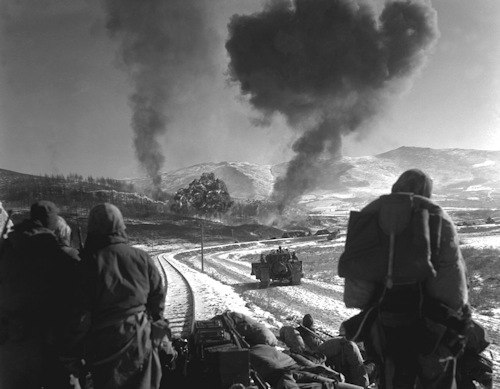 As early as 1945, the Communists began to create unrest in South Korean territory, to which the government responded with an iron fist. In 1948 the riots turned into a real insurgency of guerrillas and, in 1950, the North openly invaded the South, starting the very bloody "Korean War" which ended only in 1953 with the armistice of Panmunjeom.
As early as 1945, the Communists began to create unrest in South Korean territory, to which the government responded with an iron fist. In 1948 the riots turned into a real insurgency of guerrillas and, in 1950, the North openly invaded the South, starting the very bloody "Korean War" which ended only in 1953 with the armistice of Panmunjeom.
Contrary to popular opinion, the armistice of 1953 did not really silence the weapons because, despite the absence of a full-blown conventional conflict, the communist guerrilla immediately resumed dragging itself into the 60s.
In 1958, as a form of direct pressure against the Soviet Union, China (which had withdrawn its military contingent just that year) and North Korea itself, the United States decided to deploy several nuclear weapons, in particular the MGR-1 missiles Honest John, cruise Martin MGM-1 Matador and the M65 “Atomic Annie” cannons capable of firing 280 mm nuclear projectiles. Although the appearance of these weapons managed to act as a deterrent to a new conventional invasion, the Americans and South Koreans soon had to come to terms with the fact that nuclear forces were of no use against Kim Il's new strategy. -sung aimed at revitalizing the communist guerrillas in South Korea on the model of what was happening in Vietnam at the time.
The fears of the Americans, South Koreans and their allies within the command of the UN Korean troops were further strengthened when, during 1966, the North Korean Armed Forces began a massive infiltration campaign that gave rise to a sort of "Almost open war" that dragged on for the next more than 3 years.
Heavily engaged in Southeast Asia, the Americans could not afford to be involved in a parallel war on the Korean Peninsula as well, so it was of prime importance that South Korea (which was also contributing to American efforts in Vietnam with a its own large contingent) was able to deploy a conventional deterrent force that could protect itself alone or with limited support from the stars and stripes. In order to achieve this, the South Koreans, soldiers unanimously defined as excellent by all Western observers, absolutely needed access to the most modern American technologies at 360 °, especially in the aeronautical field; the “Peace Spectator” program was born.
 After a short period of evaluation, the first 18 F-4Ds were ordered and transferred, drawing them directly from the USAF frontline, without waiting for the arrival of the factory new units. The first four arrived in August 1969, soon followed by all the others, and entered the ranks of the 110th TFS (Tactical Fighter Squadron) part of the 11th Fighter Wing based in Taegu. Fortunately, the newcomers F-4Ds did not have to enter the fray against the North Korean irregular forces because, starting in the second half of 1969, the intensity of the Northern war effort began to wane until it disappeared altogether, and with it also disappeared. the communist guerrilla. However, the path for the modernization of the Seoul Armed Forces was by now fixed, and in fact it continued to proceed at full speed even in the following years.
After a short period of evaluation, the first 18 F-4Ds were ordered and transferred, drawing them directly from the USAF frontline, without waiting for the arrival of the factory new units. The first four arrived in August 1969, soon followed by all the others, and entered the ranks of the 110th TFS (Tactical Fighter Squadron) part of the 11th Fighter Wing based in Taegu. Fortunately, the newcomers F-4Ds did not have to enter the fray against the North Korean irregular forces because, starting in the second half of 1969, the intensity of the Northern war effort began to wane until it disappeared altogether, and with it also disappeared. the communist guerrilla. However, the path for the modernization of the Seoul Armed Forces was by now fixed, and in fact it continued to proceed at full speed even in the following years.
In 1972 the South Korean Air Force received another 18 F-4Ds, this time sold by the USAF's 3rd TFW (Tactical Fighter Wing) stationed in Korea, part of a framework agreement under which the South Koreans would in turn surrender 36 of their Northrop F-5A Freedom Fighters to the South Vietnamese Air Force under the “Enhance Plus” program.
New batches of F-4Ds continued to arrive in the following years, equipping 3 squadrons overall. The last, of 24 units, was delivered between December 1987 and April 1988, after which the F-4D suppliers stopped.
Along with the aforementioned aircraft, the South Koreans also received the Ford Aerospace AN / AVQ-26 electro-optical aiming pods Pave Tack which greatly increased their ability to attack strategic targets using precision ammunition, particularly the laser-guided bombs of the series Paveway which South Korea received in large quantities.
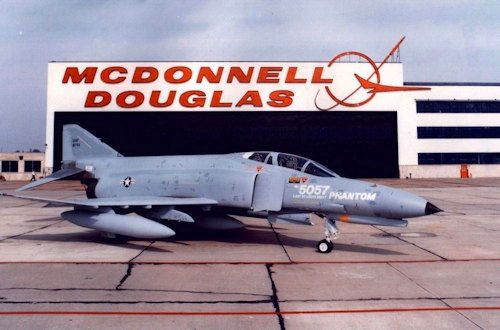 Given the excellent performance provided by the F-4Ds, the authorities of the "Blue House" decided to "build on success" and, in 1978, ordered the first batch, including 37 units, of F-4Es as part of the operation " Peace Pheasant II ”which were sent to equip the 152nd and 153rd TFS of the 17th TFW based in Chongju. A noteworthy curiosity is that the last example of this lot, Korean identification number 78-0744, was also the 5057th and last Phantom produced in the St Louis plants, where McDonnell Douglas was based (however it is good to remember that not all sources agree on this point, given that some claim that in reality this last specimen was instead destined for the Turkish Air Force!).
Given the excellent performance provided by the F-4Ds, the authorities of the "Blue House" decided to "build on success" and, in 1978, ordered the first batch, including 37 units, of F-4Es as part of the operation " Peace Pheasant II ”which were sent to equip the 152nd and 153rd TFS of the 17th TFW based in Chongju. A noteworthy curiosity is that the last example of this lot, Korean identification number 78-0744, was also the 5057th and last Phantom produced in the St Louis plants, where McDonnell Douglas was based (however it is good to remember that not all sources agree on this point, given that some claim that in reality this last specimen was instead destined for the Turkish Air Force!).
Subsequently, the RoKAF took delivery of numerous other F-4Es, all coming from the reserves of the USAF and the American ANG and also in this case, as in that of the F-4D, the aircraft were optimized for the use of precision ammunition. by integrating the AN / AVQ-26 Pave Tack pods.
The latest version of the Phantom to join the South Korean ranks was the reconnaissance RF-4C. The first 12 RF-4Cs were acquired by RoKAF in 1990 when the USAF's 460th TRG (Tactical Reconnaissance Group) was dissolved. These were followed by 11 more from a second batch and 4 from a third.
All South Korean RF-4Cs were concentrated in the 131st TRS (Tactical Reconnaissance Squadron) part of the 39th TRG and equipped with pods for AN / ALQ-131 electronic countermeasures in order to increase their survivability in action in a hostile environment characterized by presence of redundant anti-aircraft defenses.
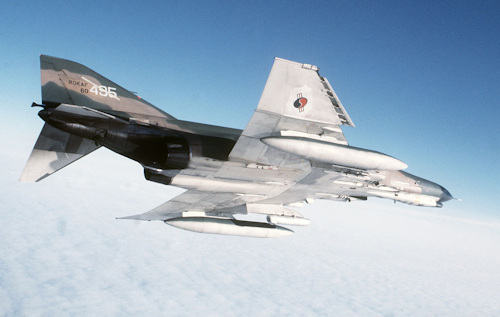 In 1989, the South Korean Defense Development Agency issued a directive under which it would explore the possibility of investing time and resources in an ambitious plan to modernize its F-4D / E fleet to equip them with new radars and state-of-the-art avionics following the same path that other users of the stars and stripes twin-engine such as Japan, Germany, Greece, Israel and Turkey were traveling in the same period. Two proposals, respectively by the German DASA and the American Rockwell, centered on the possibility of making the South Korean Phantoms able to compete in modern BVR air combat scenarios through the integration of the AN / APG-66 radar and AIM- missiles. 120 AMRAAMs (which would have made them fully comparable, in terms of performance, to the German F-4F ICEs and the Japanese F-4EJ Kai already described in the previous analysis) were seriously considered, but the scarcity of funds and the subsequent economic crisis of the "Asian Tigers" of the 90s forced RoKAF to fall back towards less ambition solutions that envisaged only structural interventions to increase the life of the cells and the installation of new avionics and instrumentation for the integration of new armaments for air-to-ground missions. And it was precisely in the air-to-ground role that the South Korean F-4s have, from the early 90s until now, expressed their added value, within the complex system of conventional strategic deterrence created by South Korea against its dangerous neighbors.
In 1989, the South Korean Defense Development Agency issued a directive under which it would explore the possibility of investing time and resources in an ambitious plan to modernize its F-4D / E fleet to equip them with new radars and state-of-the-art avionics following the same path that other users of the stars and stripes twin-engine such as Japan, Germany, Greece, Israel and Turkey were traveling in the same period. Two proposals, respectively by the German DASA and the American Rockwell, centered on the possibility of making the South Korean Phantoms able to compete in modern BVR air combat scenarios through the integration of the AN / APG-66 radar and AIM- missiles. 120 AMRAAMs (which would have made them fully comparable, in terms of performance, to the German F-4F ICEs and the Japanese F-4EJ Kai already described in the previous analysis) were seriously considered, but the scarcity of funds and the subsequent economic crisis of the "Asian Tigers" of the 90s forced RoKAF to fall back towards less ambition solutions that envisaged only structural interventions to increase the life of the cells and the installation of new avionics and instrumentation for the integration of new armaments for air-to-ground missions. And it was precisely in the air-to-ground role that the South Korean F-4s have, from the early 90s until now, expressed their added value, within the complex system of conventional strategic deterrence created by South Korea against its dangerous neighbors.
Over the course of just over two decades, the South Korean Air Force received a total of 222 McDonnell Douglas F-4 Phantom IIs split between 92 F-4Ds, 103 F-4Es and 27 RF-4Cs, and in the early 2000s at the time of the heyday of the national Phantom fleet, South Korea lined up no less than 6 units based on the twin-engine St Louis:
- 110th TFS / 11th TFW on F-4D based in Taegu;
- 151th TFS / 11th TFW on F-4D based in Taegu;
- 132nd TFS / 17th TFW on F-4E based in Chongju;
- 152nd TFS / 17th TFW on F-4E based in Chongju;
- 153nd TFS / 17th TFW on F-4E based in Chongju;
- 131st TRS / 39th TRG on RF-4C based in Suwon.
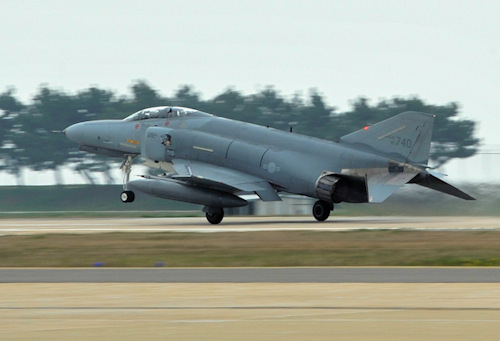 The intense operational use has resulted in a certain friction in the number of cells available over the years. The open sources available to us on the Aviation Safety Network speak of about 10 F-4s lost due to accidents of various kinds in the last 30 years, from 1990 to today. However, it is not easy to access data prior to this date, and in any case, unlike what happens for other aeronautics of the advanced world, that of South Korea does not usually receive the attention it deserves given its importance.
The intense operational use has resulted in a certain friction in the number of cells available over the years. The open sources available to us on the Aviation Safety Network speak of about 10 F-4s lost due to accidents of various kinds in the last 30 years, from 1990 to today. However, it is not easy to access data prior to this date, and in any case, unlike what happens for other aeronautics of the advanced world, that of South Korea does not usually receive the attention it deserves given its importance.
However, it should be noted that South Korean military personnel have earned an excellent reputation for discipline and operational capabilities and this has ensured that aircraft maintenance never fails, even in years of scarce financial resources. . Not only that, the aeronautical industries of South Korea have proved capable of producing all the components for the aircraft in service and at a factory standard even higher than that of many Western countries, so much so that several "rogue states" such as Turkey, Iran and Pakistan have repeatedly turned (under the counter) to South Korean industries to obtain the spare parts necessary to ensure the operation of their Western aircraft such as F-4, F-5 and F-16.
During the Iran-Iraq war, Iran even went so far as to purchase 12 F-4Ds from South Korea, but any subsequent supply was blocked after the direct intervention of the then Reagan administration.
With the passage of time, the wear and tear of the cells and the entry into service of new models of fighter aircraft have led to an inevitable decrease in the number of F-4s in service, so much so that today, of the 222 F-4s delivered, remain in service 71 (concentrated in the 10th TFW based in Suwon), all of the F-4E version, while all the F-4Ds, the RF-4Cs and a good third of the F-4Es have already been canceled.
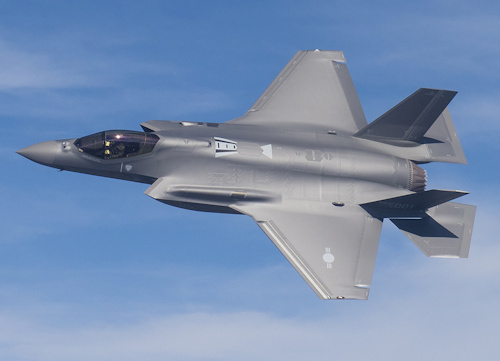 According to the modernization plans of the South Korean Armed Forces, in a couple of years the Air Force should reach its maximum level of power, deploying no less than 712 aircraft divided between 162 KAI T-50 Golden Eagle, 193 Northrop F-5 Tiger II, 167 General Dynamics F-16 Fighting Falcon, 71 McDonnell Douglas F-4 Phantom II, 59 McDonnell Douglas F-15K Strike Eagle and 60 Lockheed Martin F-35 Lightning II (photo). It is interesting to note, however, that, despite their total number accounting for only 10% of the overall combat line, the F-4s still maintain an indisputable leading role in the South Korean conventional deterrence system. According to the plans of the Seoul strategists, in fact, in the event that the delicate balance in the Korean peninsula should falter and the weapons thunder again, it will be up to the F-4, together with the F-15K and F-35 (the latter when they become fully operational) the task of carrying out deep penetration missions to attack strategic targets located well within the territory of North Korea, without forgetting the infantry support missions in which the F-4 has always excelled.
According to the modernization plans of the South Korean Armed Forces, in a couple of years the Air Force should reach its maximum level of power, deploying no less than 712 aircraft divided between 162 KAI T-50 Golden Eagle, 193 Northrop F-5 Tiger II, 167 General Dynamics F-16 Fighting Falcon, 71 McDonnell Douglas F-4 Phantom II, 59 McDonnell Douglas F-15K Strike Eagle and 60 Lockheed Martin F-35 Lightning II (photo). It is interesting to note, however, that, despite their total number accounting for only 10% of the overall combat line, the F-4s still maintain an indisputable leading role in the South Korean conventional deterrence system. According to the plans of the Seoul strategists, in fact, in the event that the delicate balance in the Korean peninsula should falter and the weapons thunder again, it will be up to the F-4, together with the F-15K and F-35 (the latter when they become fully operational) the task of carrying out deep penetration missions to attack strategic targets located well within the territory of North Korea, without forgetting the infantry support missions in which the F-4 has always excelled.
The "tools of the trade" with which the F-4 would carry out their missions range from multiple rocket launchers such as LAU-3 and LAU-68, cluster bombs CBU-58, CBU-87 and CBU-97 , the conventional bombs of the Mark 80 series (in particular the Mark 84, also called BLU 117) and the laser guided bombs of the series Paveway (of which South Korea has purchased all the models that have been developed), the AGM-88 HARM anti-radiation missiles, the GBU-28 and GBU-38 JDAM high-penetration anti-bunker bombs, the low-diameter planing bombs ( SDB) GBU-39B and KGGB (the latter of entirely national development), the air-launched cruise missiles Taurus KEPD 350 and Hyunmoo III (in its aerial version), and air-to-ground guided missiles such as the veteran AGM-65 Maverick, the AGM-130, the AGM-84K SLAM-ER and, most importantly, the Lockheed Martin / Rafael AGM-142 Raptor / Popeye / Have Nap. The latter is a missile of Israeli origin purchased in large numbers and then produced under license by South Korea solely for use by the F-4, as opposed to all the other weapons mentioned above which have been integrated in whole or in part also on the other types of RoKAF fighter aircraft.
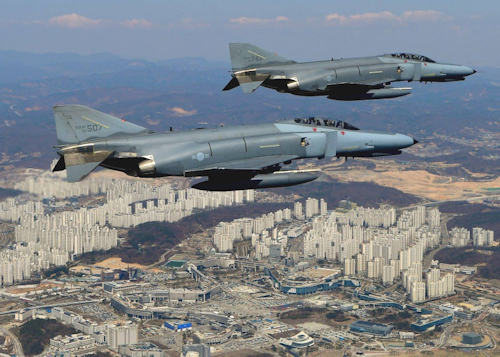
Officially accredited with an operational range of 78 kilometers, it is very likely that the AGM-142 is capable of hitting targets located at 100, 320 or even 1500 kilometers depending on the thematic literature consulted. Added to the in-flight refueling capacity guaranteed by the 4 Airbus A330 Multi Role Tanker Transport (MRTT), this makes the F-4E / AGM-142 combination a lethal combination with a formidable strategic value that would allow South Koreans to hit targets located anywhere on the territory. North Korea, but also in China, Japan and even the Russian Far East, with conventional high-powered or nuclear warheads, should Seoul choose the nuclear path to strengthen its deterrence capacity against all its bulky neighbors.
Despite his more than 51 years of service at RoKAF, the McDonnell Douglas F-4 Phantom II continues to serve, albeit in progressively smaller ranks, with pride in the front line of combat, and if all goes according to the plans of the general staff, it will be definitively withdrawn during the two-year period 2024-25 when what, hopefully, will be its worthy successor, the first fifth generation fighter entirely "made in Korea": the KAI KF-X "Boramae" (Falco) enters service . However, waiting for that date, and considering that the Far Eastern area continues to be one of the hottest on the planet, with the destabilizing and erratic policies of China and North Korea always on the verge of blowing up the fragile local and global balances , the "Bunker Busters" of the "Daehanminguk Gong-gum" will continue to fly, pugnacious and fully armed, to protect the integrity of their nation.
Photo: ROKAF / USMC / US Air Force / McDonnell Douglas Corporation












